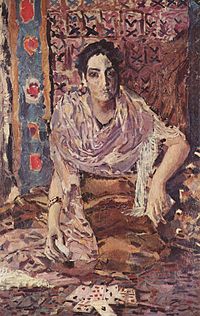

Cartomancy is fortune-telling or divination using a deck of cards.[1] Forms of cartomancy appeared soon after playing cards were introduced into Europe in the 14th century.[2] Practitioners of cartomancy are generally known as cartomancers, card readers, or simply readers.
Cartomancy using standard playing cards was the most popular form of providing fortune-telling card readings in the 18th, 19th, and 20th centuries. The standard 52-card deck is often augmented with jokers or even with the blank card found in many packaged decks. In France, the 32-card piquet stripped deck is most typically used in cartomantic readings, although the 52 card deck can also be used. (A piquet deck can be a 52-card deck with all of the 2s through the 6s removed. This leaves all of the 7s through the 10s, the face cards, and the aces.)
In English-speaking countries, the most common form of cartomancy is generally tarot card reading. Tarot cards are almost exclusively used for this purpose in these places.[3]
The most popular method of cartomancy using a standard playing deck is referred to as the Wheel of Fortune.[3][4] Here, the reader removes cards at random and assigns significance to them based on the order they were chosen.[3] Though the interpretation of various cards varies by region, the common significators for the future are as follows:
| Card | Significance |
|---|---|
| King of Hearts | An adult man with sandy, dark blond, or light brown hair, with brown, blue, or hazel eyes. Usually a family member or other loved one. Paternal and family-oriented. |
| King of Diamonds | An adult man with red or light blond hair with blue, green, or gray eyes. Usually a wealthy man in an authority position. |
| King of Clubs | An adult man with medium or dark brown hair, with brown, blue, or hazel eyes. Usually a married businessman (although business could have a sexual, rather than commercial, interpretation.) |
| King of Spades | An adult man with dark brown to black hair, and dark brown eyes. Usually a widower or divorced man, or a man from a foreign country. Ambitious and powerful, can be arrogant and deceptive. |
| Queen of Hearts | An adult woman with sandy, dark blond, or light brown hair, with brown, blue, or hazel eyes. Usually a family member or other loved one. Maternal and family-oriented. |
| Queen of Diamonds | An adult woman with red or light blond hair with blue, green, or gray eyes. Usually a wealthy woman in an authority position. |
| Queen of Clubs | An adult woman with medium or dark brown hair, with brown, blue, or hazel eyes. Usually a businesswoman or social butterfly. |
| Queen of Spades | An adult woman with dark brown to black hair, and dark brown eyes. Usually a widow or divorced woman, or a woman from a foreign country. Ambitious and intelligent, can be cold, calculating, or spiteful. |